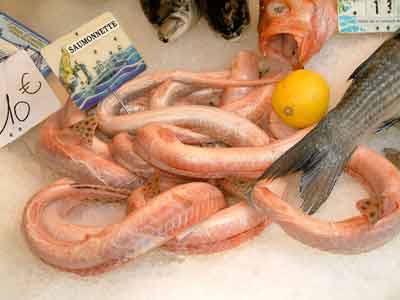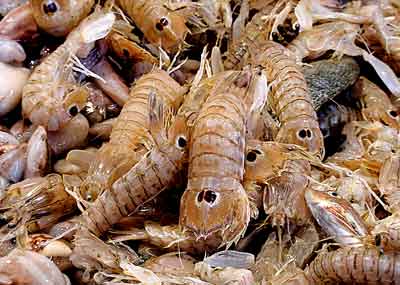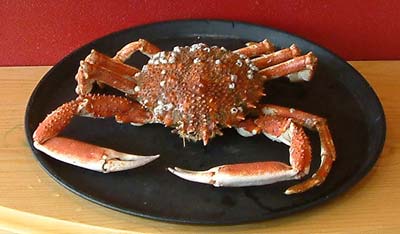Bleak. A small, elongated, white-fleshed fish, abundant in lakes and quiet waterways. Its scales, which are thin and silvery, come away easily. The flesh of the pond bleak is of poor quality, but that of the river variety is fairly good, although it is full of little bones. It is about 15 cm (6 inches) long and invariably served fried.

Huss. This species of dogfish has a grey-brown skin with quite pronounced dark spots. Because of its relative similarity to a shark the coarse skin is usually removed by fishmongers. These fish grow to about 80 cm (32 inches) in length. The flesh is white or pinkish with a firm texture and good flavour. It is boneless. It is also commonly known as the spotted dogfish or nursehound or, in some places, as rock salmon or rock eel. Spurdog, smoothound and tope are all sold as huss. It is an excellent addition to soups because of its texture. It feeds on shellfish which flavours its own firm, white flesh.

Mantis shrimp. Squill. A flat tailed crustacean with a delicate flavour found from the eastern coast of North America to the Adriatic and Mediterranean. It is related to a crab rather than a prawn and bears some resemblance to a praying mantis, a kind of flat lobster which makes a chirp like a cricket and has lilac marks on its white flesh.

A southern French name for the spider crab. This is a crab with little meat but what it has is well-flavoured. It has a large, oval spiked body and long, thin spidery legs, hence its name.
Pepper steak. A steak, fillet, sirloin or rump, though the succulence of fillet is a good foil for the crispness of the pepper, coated with broken peppercorns. Well cooked this is one of the great classic dishes Started in oil, with butter added when the steaks are turned, it will require little else in the way of a sauce, though I deglaze the pan with cognac. Some people add cream.